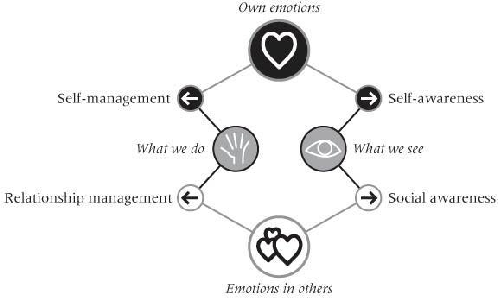

Copyright KOAP Ltd all rights reserved 2013 administrator@koap.co.uk
“To KOAP “…… Achieving organisational goals of high performance and competitive advantage amidst significant change”
Background to Emotional Intelligence
Where It Comes From
Emotional intelligence as a discrete area of study came into prominence in the mid-
High IQ Is No Guarantee of Success
Their premise for emotional intelligence was that intelligence alone is not a predetermined
feature of success in life and work. Intelligence as represented by IQ ignores aspects
of personality, emotion and behaviour that are equally, if not more likely, to show
how someone will perform. Emotional intelligence is therefore an important factor
in evaluating people for roles, in making personal and business decisions, reacting
collectively to circumstances and also in leading others. Understanding emotional
intelligence will help self-
Emotional Intelligence Matrix
In this model, emotional intelligence has four dimensions. Two dimensions have to
do with our own emotions (self-
- The first dimension, called self-
awareness, is about how aware we are of our own emotions. This is what we can see about ourselves (“What we can see” plus “Own emotions”). - The second dimension, self-
management, refers to how skilfully we can handle our own emotions (“What we do” plus “Own emotions”). - The third dimension, social awareness, describes how good we are at identifying emotions in people around us.
- The fourth dimension, relationship management, is about using emotions to build trusting
and healthy re
 lationship with people around us. For a leader, this means mainly with
peers and team members.
lationship with people around us. For a leader, this means mainly with
peers and team members.
The challenge to our emotional intelligence is to steer a path through all the possible reactions to arrive at a position where the best outcome has been achieved. Inevitably, this will be harder than acting on face value but will be the basis for a better result. Although we depend on reason and judgement in making what we see as being an intelligent decision or taking an appropriate action, intelligence alone is not necessarily enough to create the right effect or to ensure a successful outcome. Intelligence, as measured by IQ has been the benchmark for predicting how someone, or a group of people, will perform in life and in their chosen role or occupation. However, it is now no longer on its own seen as a sufficiently predictive indicator of competency. Knowing when to follow our own and others’ feelings and emotions, and when to ignore them, is a valuable attribute. Unlike IQ, whose level remains more or less constant throughout life, EQ can be improved through observation, learning and experience. Behaviour is significantly more affected by emotions than just by intelligence.